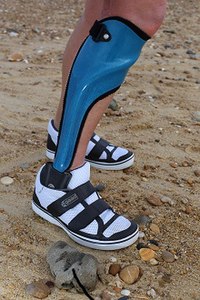
Photo from wikipedia
OBJECTIVE To assess frailty and disability among older adults with and without diabetes or foot ulcers. METHOD A descriptive, comparative, controlled, multicentre study. Equal numbers of participants were allocated to… Click to show full abstract
OBJECTIVE To assess frailty and disability among older adults with and without diabetes or foot ulcers. METHOD A descriptive, comparative, controlled, multicentre study. Equal numbers of participants were allocated to three groups: (I) no diabetes/no foot ulcers (control), (II) diabetes but no foot ulcers or (III) diabetes and foot ulcers. Individuals with arterial, venous, pressure or mixed ulcers were not included. We collected data using three methods: a sociodemographic questionnaire and the validated Brazilian versions of the Edmonton Frail Scale and Stanford Health Assessment Questionnaire 20-item Disability Scale (HAQ-20). RESULTS A total of 150 older people took part in the study. The majority of participants were female (n=84, 56%), married (n=86, 57%) and did not exercise (n=94, 63%). Their age ranged from 67.7-71.5 years. In group I, 32 (64%) patients showed no evidence of frailty. In group II, 18 (36%) patients and 12 (24%) patients were 'apparently vulnerable' and 'mildly frail', respectively and in group III 21 (42%) patients and 15 (22%) patients had 'moderate' and 'severe frailty', respectively. The mean total HAQ-20 scores were 0.24, 0.52, and 2.44 for groups I, II, and III, respectively. Patients in group III reported significantly higher scores on all HAQ-20 categories compared with patients in groups I and II. CONCLUSION Older patients with DFUs showed frailty and physical disability in activities of daily living.
Journal Title: Journal of wound care
Year Published: 2018
Link to full text (if available)
Share on Social Media: Sign Up to like & get
recommendations!